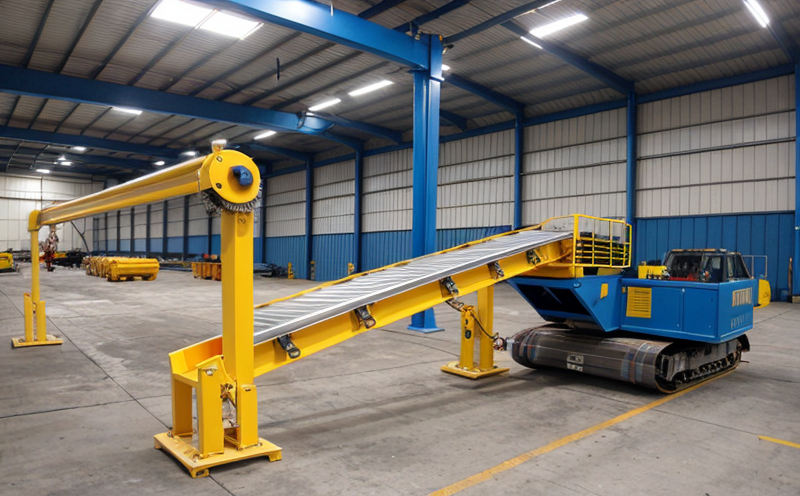ISO 340 Conveyor Belt Fire Resistance Testing
The ISO 340 standard is a critical component in ensuring conveyor belt systems are capable of withstanding fire hazards, thus protecting lives and assets in mining environments. Mining operations often involve extensive use of conveyor belts to transport materials over long distances. These belts can be exposed to various fire risks such as electrical faults or accidental ignition from machinery.
The testing procedure outlined in ISO 340 is designed to evaluate the performance of conveyor belt assemblies under controlled conditions intended to simulate real-world fire scenarios. This ensures that if a fire were to break out, the damage would be minimized by the belt’s inherent characteristics and design. The standard applies specifically to rubber or plastic conveyor belts used for transporting materials in mining operations.
The testing involves subjecting the belt assembly to a prescribed heat source until it reaches a specified temperature over a set duration. During this process, various parameters are monitored including flame propagation rate, smoke production, and structural integrity of the belt. Compliance with these criteria is essential for ensuring safety standards are met within mining facilities.
Understanding the significance of fire resistance in conveyor belts helps quality managers make informed decisions about purchasing and implementing appropriate safety measures. By adhering to ISO 340 guidelines, companies demonstrate their commitment to worker safety while also meeting regulatory requirements set forth by national and international bodies.
In summary, ISO 340 testing plays a vital role in safeguarding mining operations against potential fire risks associated with conveyor belts. It provides reassurance that the equipment installed is capable of performing optimally even under adverse conditions. This not only enhances operational efficiency but also contributes significantly to overall safety protocols within mines.
Scope and Methodology
| Parameter | Description |
|---|---|
| Belt Material | Rubber or plastic conveyor belts used for transporting materials in mining operations. |
| Testing Conditions | Subjecting the belt assembly to a prescribed heat source until it reaches a specified temperature over a set duration. |
| Monitoring Parameters | Flame propagation rate, smoke production, and structural integrity of the belt during testing. |
| Acceptance Criteria | Compliance with predefined limits for each monitored parameter to ensure safe operation under fire conditions. |
The methodology described in ISO 340 involves several key steps. Initially, the conveyor belt assembly is prepared according to specified dimensions and configurations relevant to its intended use within mining operations. Once prepared, the belt undergoes rigorous testing where it is exposed to a controlled heat source designed to simulate fire conditions.
During this exposure period, various parameters are continuously monitored using advanced instrumentation. These include measuring the rate at which flames spread across the surface of the belt and quantifying the amount of smoke generated during combustion. Additionally, structural integrity tests assess whether any significant damage occurs throughout the duration of the test.
The results obtained from these measurements are compared against established acceptance criteria defined in ISO 340. Compliance with these standards ensures that the tested conveyor belts meet minimum performance requirements for fire resistance. Non-compliance may indicate areas requiring improvement or further investigation into potential design flaws.
Customer Impact and Satisfaction
- Enhanced Safety: Ensures that conveyor belts can withstand fire hazards without compromising worker safety.
- Regulatory Compliance: Helps mining companies meet stringent regulatory requirements for fire safety in operations.
- Operational Efficiency: Minimizes downtime and disruptions caused by unexpected failures due to fire incidents involving conveyor belts.
- Cost Savings: Reduces insurance premiums and potential liabilities associated with property damage or injuries resulting from fires.
- Reputation Building: Demonstrates commitment to quality and safety, enhancing the reputation of both suppliers and end-users.
The implementation of ISO 340 testing has numerous positive impacts on customers. By ensuring that conveyor belts meet rigorous fire resistance standards, mining companies can operate with greater confidence knowing they have taken all necessary precautions against potential hazards. This not only promotes safer working environments but also fosters trust among stakeholders.
Environmental and Sustainability Contributions
Compliance with ISO 340 contributes positively to both environmental sustainability and corporate social responsibility initiatives within the mining sector. By adhering to stringent fire resistance standards, companies reduce the risk of catastrophic incidents that could lead to environmental degradation or pollution.
The use of resilient conveyor belts enhances operational continuity by minimizing disruptions caused by fires or other emergencies. This leads to reduced energy consumption as non-stop operations are maintained even during challenging conditions. Additionally, the adoption of sustainable practices such as regular maintenance and proper disposal of used materials further supports eco-friendly mining activities.
ISO 340 testing aligns with broader sustainability goals by promoting safer working environments which contribute directly towards improved worker health and safety outcomes. These measures ultimately lead to more responsible business practices that benefit all parties involved—employees, communities surrounding mines, and the environment itself.





